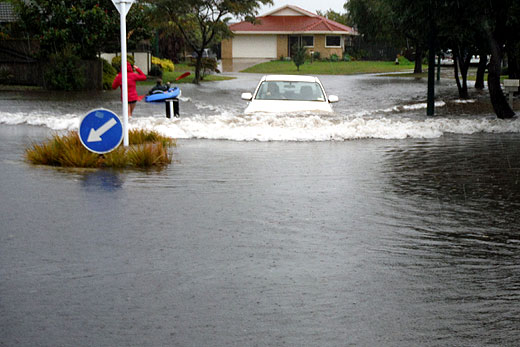Tauranga City Council is throwing its support behind a comprehensive national report aimed at reducing the social and economic impact of natural hazards in New Zealand.
The Insurance Council of New Zealand recently released a 15-point plan regarding these reductions, and believe heeding the call will help keep insurance available and affordable for all.
Flooding in Mount Maunganui from earlier this year. Photo: File.
Included in the points is developing a national plan, addressing local natural hazards and a push for safer commercial buildings.
On top of the ever-present risk of earthquakes, volcanoes and tsunamis, 2013 and 2014 were among the most expensive years for weather-related events in New Zealand.
Tauranga City Council says there is growing support nationally among hazard and risk management staff for better integration of the governing legislation.
Natural hazards are addressed by both TCC and the Bay of Plenty Regional Council, as well as Civil Defence.
TCC also welcomes more certainty around the determination of risk within New Zealand for natural hazards.
Flooding during this year's Easter storm in mid-April prompted more than 10,000 insurance claims, with more than $20 million paid out in commercial material damage and motor vehicles accounting for $3 million.
Up until September the insured cost of weather-related damage nationwide was more than $135.4 million.
TCC says within the Bay of Plenty, collaboration between regional and local government has already resulted in initiatives to deliver on the ethos of the insurance council report – some leading the way in New Zealand.
These include the Bay of Plenty Regional Council's development, recent notification on the risk-based approach to natural hazard management, and TCC undertaking an approach to understanding tsunami risks after unveiling tsunami safe zones.
'The approach adopted for tsunami risk mapping ensured that regional, local and emergency management activities were included in the development of evacuation route planning and it will assist in the development of new parts of Wairakei and Te Tumu over the next two decades,” reads the statement.
A similar approach to risk reduction is being taken through the stormwater improvement project.
Insurance Council of New Zealand chief executive Tim Grafton says implementation of legislative and strategic recommendations needs to happen because New Zealand remains one of the most vulnerable countries to the impact of natural disasters for an economy of our size.
He says based on data going back to 1900, NZ can expect to face, on average, annual costs of $1.6 billion from natural disasters.
'Without risk reduction measures the cost from natural disasters will increase,” he says.
'We cannot control the forces of nature, but we can reduce their impact significantly by building New Zealand's capacity to withstand and recover from natural disasters.”
To view the insurance council's report in full click here.



0 comments
Leave a Comment
You must be logged in to make a comment.